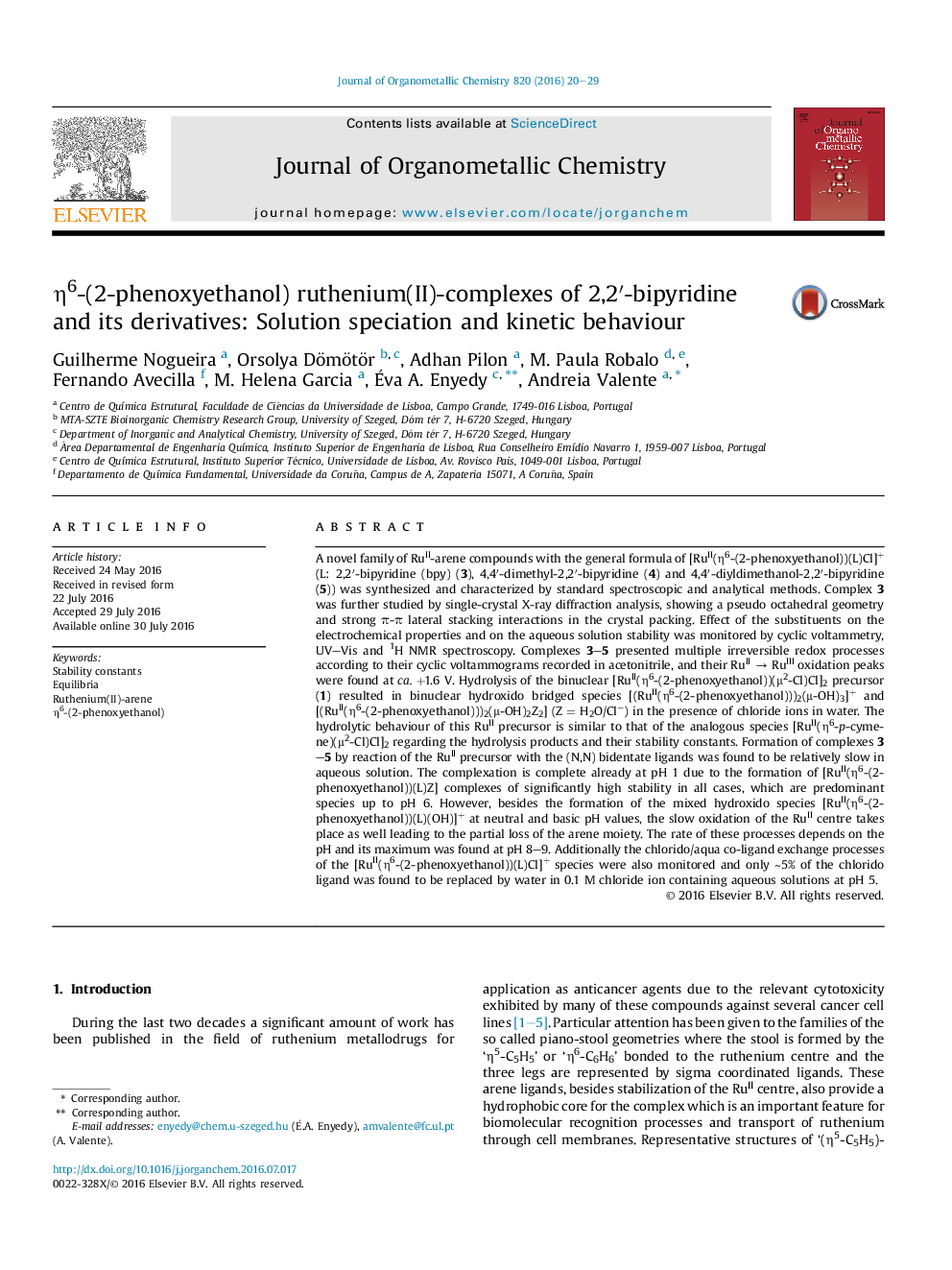| کد مقاله | کد نشریه | سال انتشار | مقاله انگلیسی | نسخه تمام متن |
|---|---|---|---|---|
| 1321579 | 1499826 | 2016 | 10 صفحه PDF | دانلود رایگان |

• Three new [RuII(η6-(2-phenoxyethanol))(L)Cl]+ (L = bipyridine and its derivatives) complexes.
• X-ray structure of [RuII(η6-(2-phenoxyethanol))(2,2′-bipyridine)Cl][PF6] complex.
• Oxidation potentials depend on the σ-donating ability of the ligands.
• High stable complexes at acidic pH, arene loss and oxidation of RuII at higher pH.
• Aqua/chlorido ligand exchange constants were calculated for the studied RuII complexes.
A novel family of RuII-arene compounds with the general formula of [RuII(η6-(2-phenoxyethanol))(L)Cl]+ (L: 2,2′-bipyridine (bpy) (3), 4,4′-dimethyl-2,2′-bipyridine (4) and 4,4′-diyldimethanol-2,2′-bipyridine (5)) was synthesized and characterized by standard spectroscopic and analytical methods. Complex 3 was further studied by single-crystal X-ray diffraction analysis, showing a pseudo octahedral geometry and strong π-π lateral stacking interactions in the crystal packing. Effect of the substituents on the electrochemical properties and on the aqueous solution stability was monitored by cyclic voltammetry, UV–Vis and 1H NMR spectroscopy. Complexes 3–5 presented multiple irreversible redox processes according to their cyclic voltammograms recorded in acetonitrile, and their RuII → RuIII oxidation peaks were found at ca. +1.6 V. Hydrolysis of the binuclear [RuII(η6-(2-phenoxyethanol))(μ2-Cl)Cl]2 precursor (1) resulted in binuclear hydroxido bridged species [(RuII(η6-(2-phenoxyethanol)))2(μ-OH)3]+ and [(RuII(η6-(2-phenoxyethanol)))2(μ-OH)2Z2] (Z = H2O/Cl−) in the presence of chloride ions in water. The hydrolytic behaviour of this RuII precursor is similar to that of the analogous species [RuII(η6-p-cymene)(μ2-Cl)Cl]2 regarding the hydrolysis products and their stability constants. Formation of complexes 3–5 by reaction of the RuII precursor with the (N,N) bidentate ligands was found to be relatively slow in aqueous solution. The complexation is complete already at pH 1 due to the formation of [RuII(η6-(2-phenoxyethanol))(L)Z] complexes of significantly high stability in all cases, which are predominant species up to pH 6. However, besides the formation of the mixed hydroxido species [RuII(η6-(2-phenoxyethanol))(L)(OH)]+ at neutral and basic pH values, the slow oxidation of the RuII centre takes place as well leading to the partial loss of the arene moiety. The rate of these processes depends on the pH and its maximum was found at pH 8–9. Additionally the chlorido/aqua co-ligand exchange processes of the [RuII(η6-(2-phenoxyethanol))(L)Cl]+ species were also monitored and only ∼5% of the chlorido ligand was found to be replaced by water in 0.1 M chloride ion containing aqueous solutions at pH 5.
Figure optionsDownload as PowerPoint slide
Journal: Journal of Organometallic Chemistry - Volume 820, 1 October 2016, Pages 20–29